Research on Environmental Pollution Control Based on Tripartite Evolutionary Game in China’s New-Type Urbanization
Abstract
1. Introduction
2. Model Assumptions and Symbol Description
2.1. Description of the Model
2.2. Model Assumptions and Symbolic Assumptions
3. Model Analysis
3.1. Expected Returns and Average Group Returns of Three Parties in Evolutionary Game Model
- (1)
- Assuming that the expected return and the average group return of local governments choosing strict supervision are M1y and M1, respectively.
- (2)
- Assuming that the expected return and the average group return of the polluting companies choosing low pollution are M2y and M2, respectively.
- (3)
- Assuming that the expected return and the average group return of the public choosing participation are M3y and M3, respectively.
3.2. Evolutionary Stable Strategy Based on the Replicator Dynamics Equation
- (1)
- Replicator dynamics equation and stability analysis of local governments’ strategies of strict supervision.
- (i)
- When z = z*, F(x) is ≡ 0, indicating that x is stable for any value;
- (ii)
- When z ≠ z*, x = 0 and x = 1 may serve as two equilibrium points of x. The first derivative of F(x) is as follows:
- (2)
- Replicator dynamics equation and stability analysis of polluting companies’ strategies of low pollution.
- (3)
- Replicator dynamics equation and stability analysis of the public’s strategies of participation.
3.3. Analysis of Evolutionary Strategies Stability
- Local governments play a crucial role in enforcing environmental pollution control. When local governments adopt negative supervision, two stable states emerge: ESS (0,0,0) and ESS (0,0,1). This implies that if local governments adopt negative supervision strategies, polluting companies may always choose high-pollution strategies regardless of whether the public engages in participation strategies.
- Under the strict supervision of the local governments, two evolutionary stable strategies are observed: ESS (1,0,1) and ESS (1,0,0). Despite strict supervision by local governments, polluting companies may still engage in high-pollution strategies due to factors such as fines (F), subsidies (P), potential income loss (W2), and incentives (T) being insufficient for public participation, leading to environmental pollution control outcomes falling short of expectations.
- The conditions for ESS (1,1,1) and ESS (1,0,1) demonstrate that public participation can effectively enhance local government supervision and curb high-pollution strategies by polluting companies. Therefore, ESS (1,1,1) represents the most optimal state; especially through cooperation among the three parties, local governments can provide subsidies for polluting companies and incentives for public participation to enhance their motivation in environment pollution control. In return, the participation of the public can reduce the supervision costs of the local governments and provide a larger market for low-polluting enterprises. At the same time, polluting companies can provide economic development for local governments and the public, thereby maximizing the overall benefits.
4. Numerical Simulation Analysis
5. Conclusions
- (1)
- The system’s ESS may undergo sudden shifts as influencing factors continue to change during the process of environmental management. The supervision role of local governments can shift from negative to positive with improvements in factors such as additional environmental and social benefits, public credibility loss, and reduced supervision costs. Similarly, the behavioral strategies of polluting companies and the public can change based on related factors. By understanding the transformation paths among these stable states, a theoretical foundation can be established to guide the evolution of environmental pollution behaviors toward desired strategies.
- (2)
- Local governments play a crucial role in environmental pollution control in China’s new-style urbanization. When local governments adopt negative supervision, two stable states emerge: ESS (0,0,0) and ESS (0,0,1). Without government regulatory policies and incentive measures for polluting enterprises and the public, it will be very difficult for polluting enterprises to establish stable low-pollution strategies. Thus, the central government should establish a performance evaluation system aimed at sustainable development, appropriately increasing the weight of environmental quality indicators within this system. Additionally, it should enhance the environmental monitoring system involving public participation and strengthen the oversight of local governments’ actions in controlling environmental pollution.
- (3)
- The cooperation among various parties in environmental pollution control can effectively address conflicting interests in China’s new-style urbanization. The strategies of local governments can help reduce the costs for polluting companies to adopt low-pollution measures, while also enabling public participation in environmental pollution control. The public’s participation can enhance the supervisory efficiency of local governments and impose a positive influence on the environmental strategies of polluting companies. By working together, these three parties can maximize their respective interests and encourage environmentally friendly practices, resolving challenges in balancing economic, environmental, and social development, balancing companies’ transformation and pursuit of profitability, and ultimately promoting the sustainable development of China’s new-type urbanization.
Author Contributions
Funding
Institutional Review Board Statement
Informed Consent Statement
Data Availability Statement
Acknowledgments
Conflicts of Interest
References
- Lu, J.; Li, B.; Li, H.; Al-Barakani, A. Expansion of city scale, traffic modes, traffic congestion, and air pollution. Cities 2021, 108, 102974. [Google Scholar] [CrossRef]
- Tang, W.; Pei, Y.; Zheng, H.; Zhao, Y.; Shu, L.; Zhang, H. Twenty years of China′s water pollution control: Experiences and challenges. Chemosphere 2022, 295, 133875. [Google Scholar] [CrossRef]
- Zhou, Y.; Zhang, X.; Zhang, C.; Chen, B.; Gu, B. Mitigating air pollution benefits multiple sustainable development goals in China. Environ. Pollut. 2024, 349, 123992. [Google Scholar] [CrossRef] [PubMed]
- Wang, A.; Hu, S.; Lin, B. Can environmental regulation solve pollution problems? Theoretical model and empirical research based on the skill premium. Energy Econ. 2021, 94, 105068. [Google Scholar] [CrossRef]
- Du, W.; Li, M. Assessing the impact of environmental regulation on pollution abatement and collaborative emissions reduction: Micro-evidence from Chinese industrial enterprises. Environ. Impact Assess. Rev. 2020, 82, 106382. [Google Scholar] [CrossRef]
- Liu, X.; Ting, R.; Jiao, G.; Liao, S.; Pang, L. Heterogeneous and synergistic effects of environmental regulations: Theoretical and empirical research on the collaborative governance of China′s haze pollution. J. Clean. Prod. 2022, 350, 131473. [Google Scholar] [CrossRef]
- Peng, X. Strategic interaction of environmental regulation and green productivity growth in China: Green innovation or pollution refuge? Sci. Total Environ. 2020, 732, 139200. [Google Scholar] [CrossRef]
- Dong, Y.; Lu, H.; Lin, H. Comprehensive study on the spatial distribution of heavy metals and their environmental risks in high-sulfur coal gangue dumps in China. J. Environ. Sci. 2024, 136, 486–497. [Google Scholar] [CrossRef] [PubMed]
- Yu, X.; Wang, P. Economic effects analysis of environmental regulation policy in the process of industrial structure upgrading: Evidence from Chinese provincial panel data. Sci. Total Environ. 2021, 753, 142004. [Google Scholar] [CrossRef]
- Sun, Y.; Du, J.; Wang, S. Environmental regulations, enterprise productivity, and green technological progress: Large-scale data analysis in China. Ann. Oper. Res. 2020, 290, 369–384. [Google Scholar] [CrossRef]
- Hao, Y.; Zheng, S.; Zhao, M.; Wu, H.; Guo, Y.; Li, Y. Reexamining the relationships among urbanization, industrial structure, and environmental pollution in China-New evidence using the dynamic threshold panel model. Energy Rep. 2020, 6, 28–39. [Google Scholar] [CrossRef]
- Huang, L.; Lei, Z. How environmental regulation affect corporate green investment: Evidence from China. J. Clean. Prod. 2021, 279, 123560. [Google Scholar] [CrossRef]
- Shen, D.; Xia, M.; Zhang, Q.; Elahi, E.; Zhou, Y.; Zhang, H. The impact of public appeals on the performance of environmental governance in China: A perspective of provincial panel data. J. Clean. Prod. 2019, 231, 290–296. [Google Scholar] [CrossRef]
- Yao, X.; He, J.; Bao, C. Public participation modes in China′s environmental impact assessment process: An analytical framework based on participation extent and conflict level. Environ. Impact Assess. Rev. 2020, 84, 106400. [Google Scholar] [CrossRef]
- Kherazi, F.Z.; Sun, D.; Sohu, J.M.; Junejo, I.; Naveed, H.M.; Khan, A.; Shaikh, S.N. The role of environmental knowledge, policies and regulations toward water resource management: A mediated-moderation of attitudes, perception, and sustainable consumption patterns. Sustain. Dev. 2024, 1–23. [Google Scholar] [CrossRef]
- Li, L.; Xia, X.H.; Chen, B.; Sun, L. Public participation in achieving sustainable development goals in China: Evidence from the practice of air pollution control. J. Clean. Prod. 2018, 201, 499–506. [Google Scholar] [CrossRef]
- Fan, W.; Wang, S.; Gu, X.; Zhou, Z.; Zhao, Y.; Huo, W. Evolutionary game analysis on industrial pollution control of local government in China. J. Environ. Manag. 2021, 298, 113499. [Google Scholar] [CrossRef] [PubMed]
- Sun, T.; Feng, Q. Evolutionary game of environmental investment under national environmental regulation in China. Environ. Sci. Pollut. R. 2021, 28, 53432–53443. [Google Scholar] [CrossRef]
- Mahmoudi, R.; Rasti-Barzoki, M. Sustainable supply chains under government intervention with a real-world case study: An evolutionary game theoretic approach. Comput. Ind. Eng. 2018, 116, 130–143. [Google Scholar] [CrossRef]
- Awaga, A.L.; Xu, W.; Liu, L.; Zhang, Y. Evolutionary game of green manufacturing mode of enterprises under the influence of government reward and punishment. Adv. Prod. Eng. Manag. 2020, 15, 416–430. [Google Scholar] [CrossRef]
- Wu, L.; Ma, T.; Bian, Y.; Li, S.; Yi, Z. Improvement of regional environmental quality: Government environmental governance and public participation. Sci. Total Environ. 2020, 717, 137265. [Google Scholar] [CrossRef]
- Dong, Y.; Ishikawa, M.; Liu, X.; Hamori, S. The determinants of citizen complaints on environmental pollution: An empirical study from China. J. Clean. Prod. 2011, 19, 1306–1314. [Google Scholar] [CrossRef]
- Chen, L.; Li, H.; Tian, F.; Xie, C.; Zhao, L. Research on Psychological Crisis Intervention Strategies under Emergencies: An Analysis Based on the Four-Party Evolutionary Game. Sustainability 2023, 15, 15226. [Google Scholar] [CrossRef]
- Munro, N. Explaining Public Participation in Environmental Governance in China. Environ. Values 2021, 30, 453–475. [Google Scholar] [CrossRef]
- Sheng, J.; Zhou, W.; Zhu, B. The coordination of stakeholder interests in environmental regulation: Lessons from China′s environmental regulation policies from the perspective of the evolutionary game theory. J. Clean. Prod. 2020, 249, 119385. [Google Scholar] [CrossRef]
- Bernini, C.; Galli, F. Economic and Environmental Efficiency, Subsidies and Spatio-Temporal Effects in Agriculture. Ecol. Econ. 2024, 218, 108120. [Google Scholar] [CrossRef]
- Liu, K.; Lin, B. Research on influencing factors of environmental pollution in China: A spatial econometric analysis. J. Clean. Prod. 2019, 206, 356–364. [Google Scholar] [CrossRef]
- Fan, W.; Yan, L.; Chen, B.; Ding, W.; Wang, P. Environmental governance effects of local environmental protection expenditure in China. Resour. Policy. 2022, 77, 102760. [Google Scholar] [CrossRef] [PubMed]
- Zhang, Z.; Song, J.; Wang, W. Study on the Behavior Strategy of the Subject of Low-Carbon Retrofit of Residential Buildings Based on Tripartite Evolutionary Game. Sustainability 2023, 15, 7629. [Google Scholar] [CrossRef]
- Alberto Aragon-Correa, J.; Marcus, A.A.; Vogel, D. The Effects of Mandatory and Voluntary Regulatory Pressures on Firms’ Environmental Strategies: A Review and Recommendations for Future Research. Acad. Manag. Ann. 2020, 14, 339–365. [Google Scholar] [CrossRef]
- Papagiannakis, G.; Voudouris, I.; Lioukas, S.; Kassinis, G. Environmental management systems and environmental product innovation: The role of stakeholder engagement. Bus. Strategy Environ. 2019, 28, 939–950. [Google Scholar] [CrossRef]
- Zhang, X.; Geng, G.; Sun, P. Determinants and implications of citizens′ environmental complaint in China: Integrating theory of planned behavior and norm activation model. J. Clean. Prod. 2017, 166, 148–156. [Google Scholar] [CrossRef]
- Wang, J.; Jia, L.; He, P.; Wang, P.; Huang, L. Engaging stakeholders in collaborative control of air pollution: A tripartite evolutionary game of enterprises, public and government. J. Clean. Prod. 2023, 418, 138074. [Google Scholar] [CrossRef]
- Zheng, S.; Wang, J.; Sun, C.; Zhang, X.; Kahn, M.E. Air pollution lowers Chinese urbanites′ expressed happiness on social media. Nat. Hum. Behav. 2019, 3, 237–243. [Google Scholar] [CrossRef] [PubMed]
- Zhao, X.; Sun, Z. The Effect of Satisfaction with Environmental Performance on Subjective Well-Being in China: GDP as a Moderating Factor. Sustainability 2020, 12, 1745. [Google Scholar] [CrossRef]
- Zhou, W.; Shi, Y.; Zhao, T.; Cao, X.; Li, J. Government regulation, horizontal coopetition, and low-carbon technology innovation: A tripartite evolutionary game analysis of government and homogeneous energy enterprises. Energy Policy 2024, 184, 113844. [Google Scholar] [CrossRef]
- Friedman, D. Evolutionary games in economics. Econometrica 1991, 59, 637–666. [Google Scholar] [CrossRef]
- Cao, W.; Yu, J. Evolutionary game analysis of factors influencing green innovation in Enterprises under environmental governance constraints. Environ. Res. 2024, 248, 118095. [Google Scholar] [CrossRef] [PubMed]
- Wu, Y.; Hu, J.; Irfan, M.; Hu, M. Vertical decentralization, environmental regulation, and enterprise pollution: An evolutionary game analysis. J. Environ. Manag. 2024, 349, 119449. [Google Scholar] [CrossRef]
- Zhou, K.; Wang, Q.; Tang, J. Evolutionary game analysis of environmental pollution control under the government regulation. Sci. Rep. 2022, 12, 474. [Google Scholar] [CrossRef]

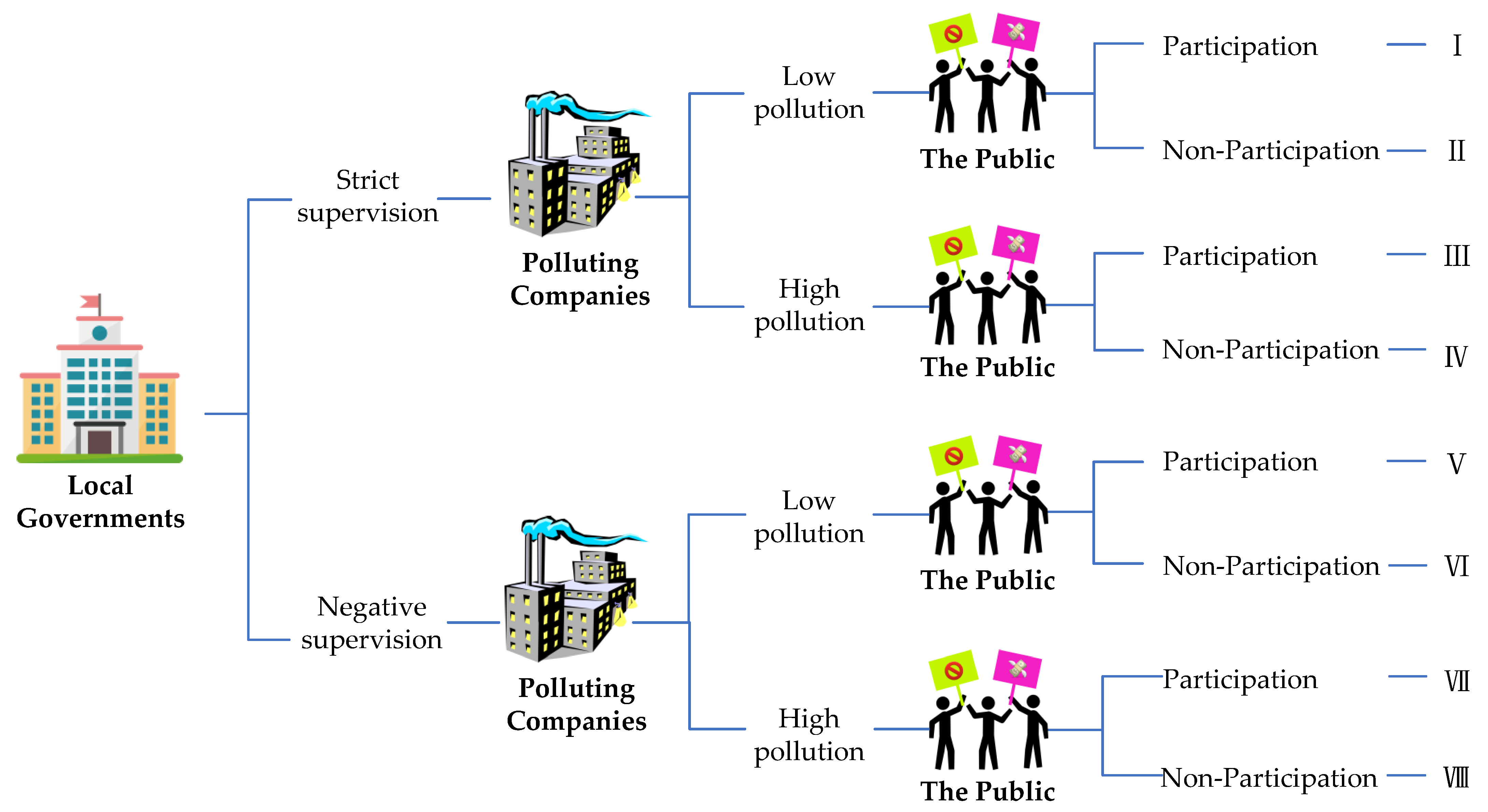
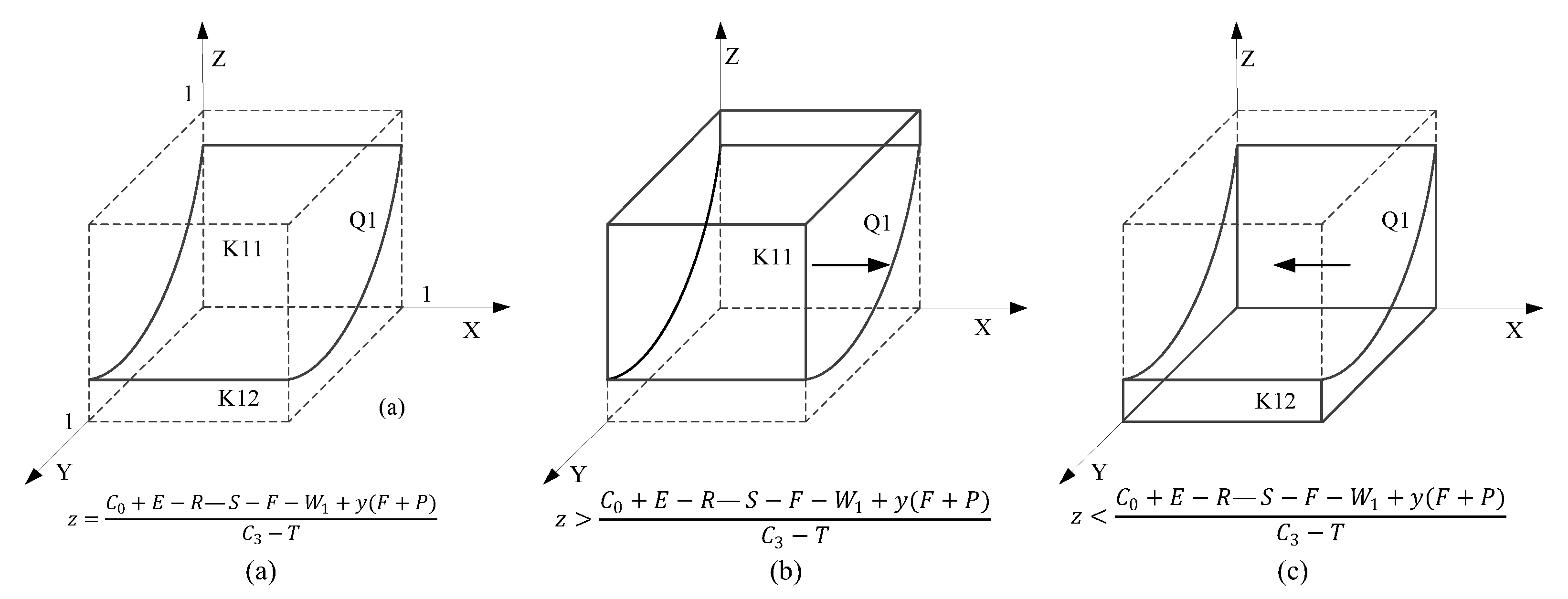

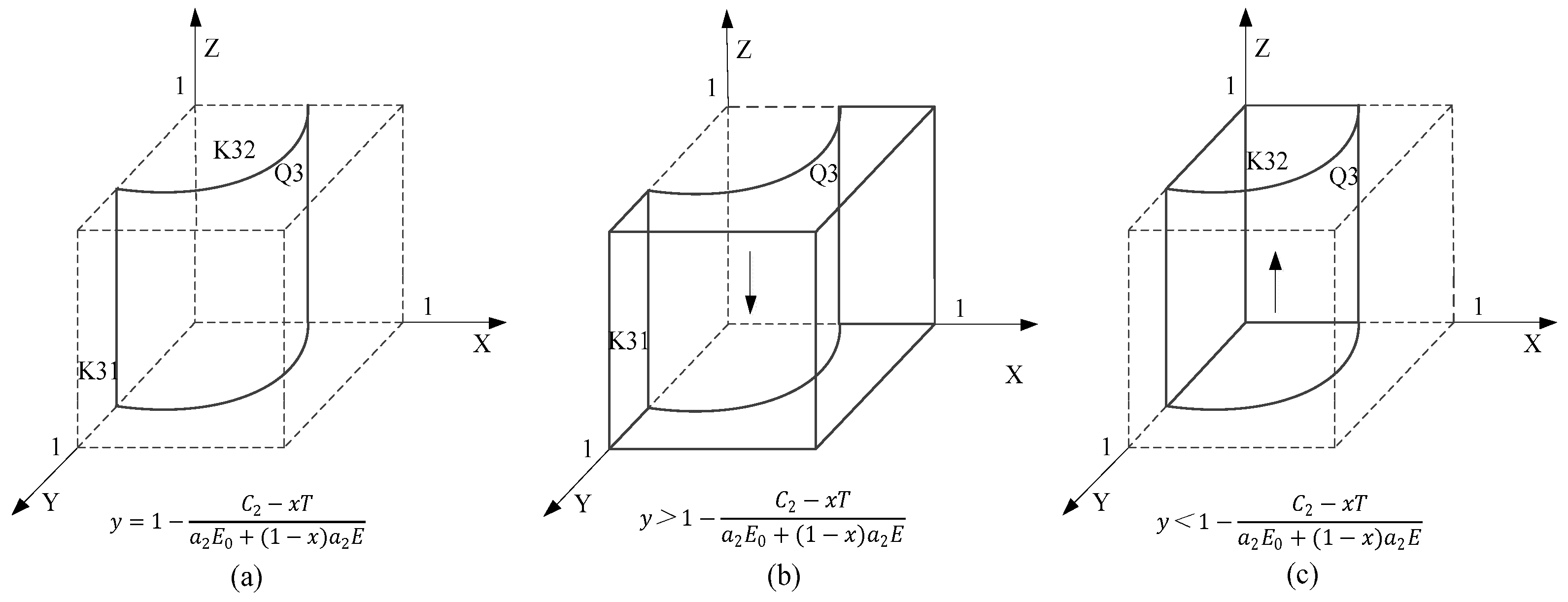

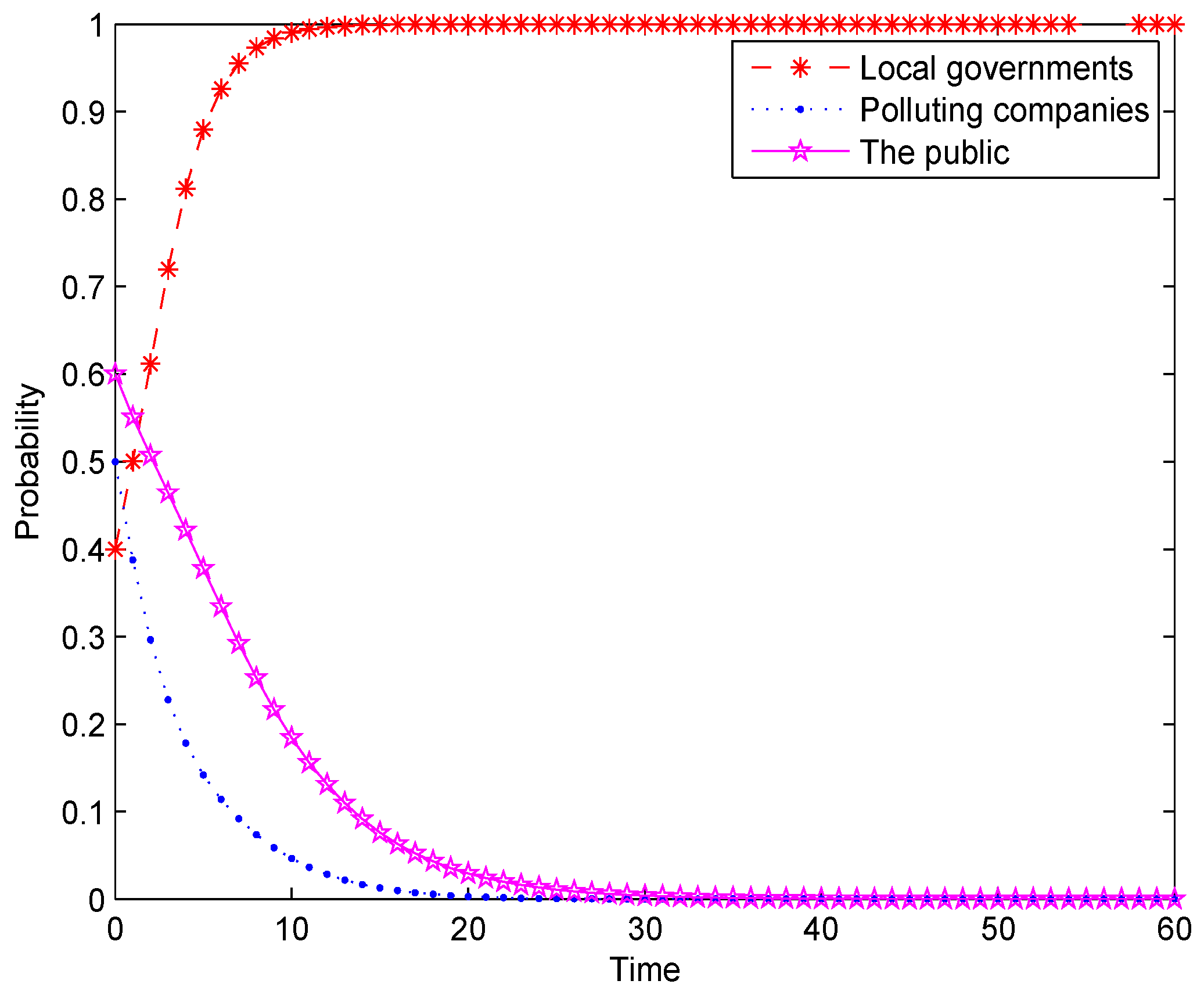
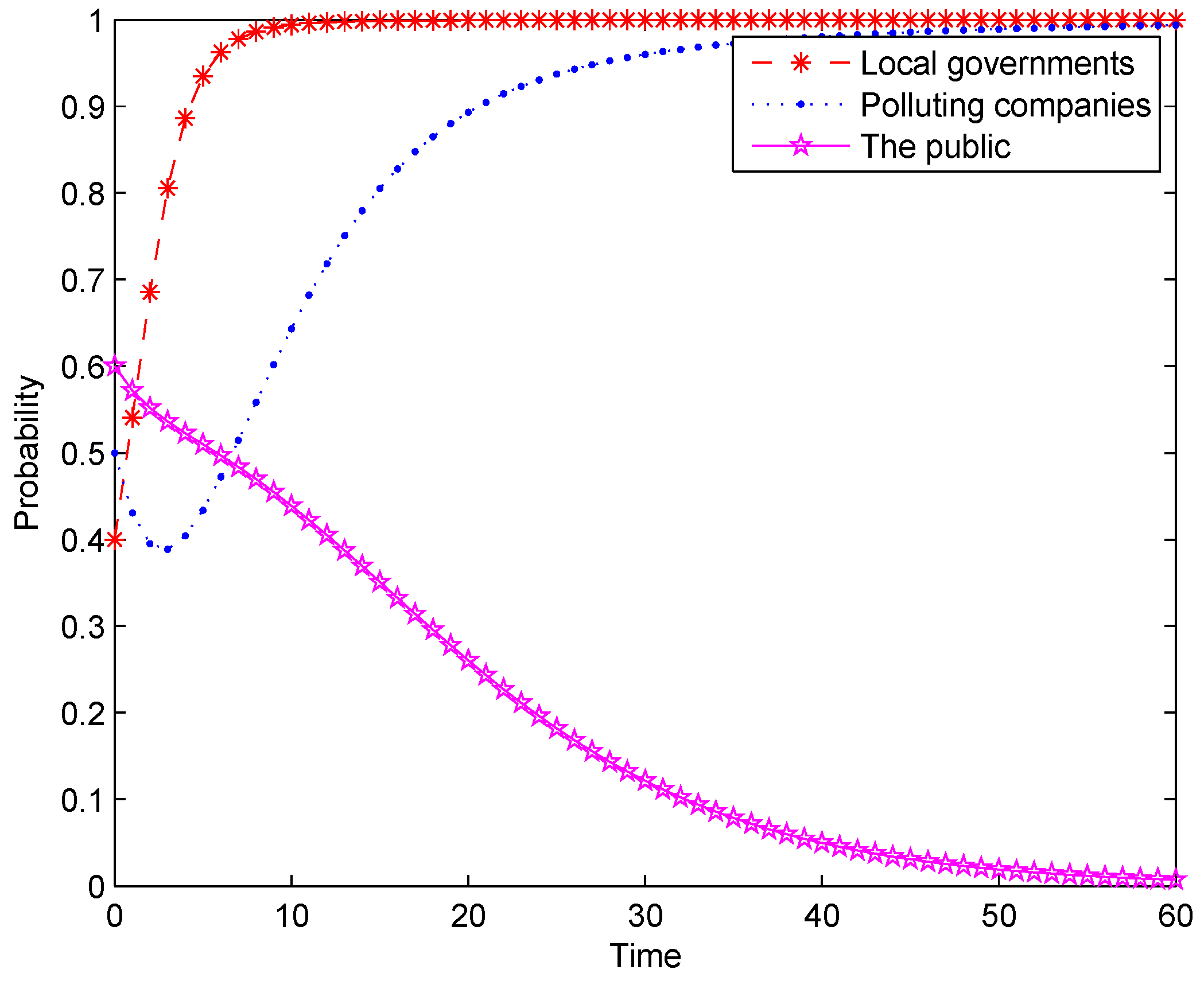

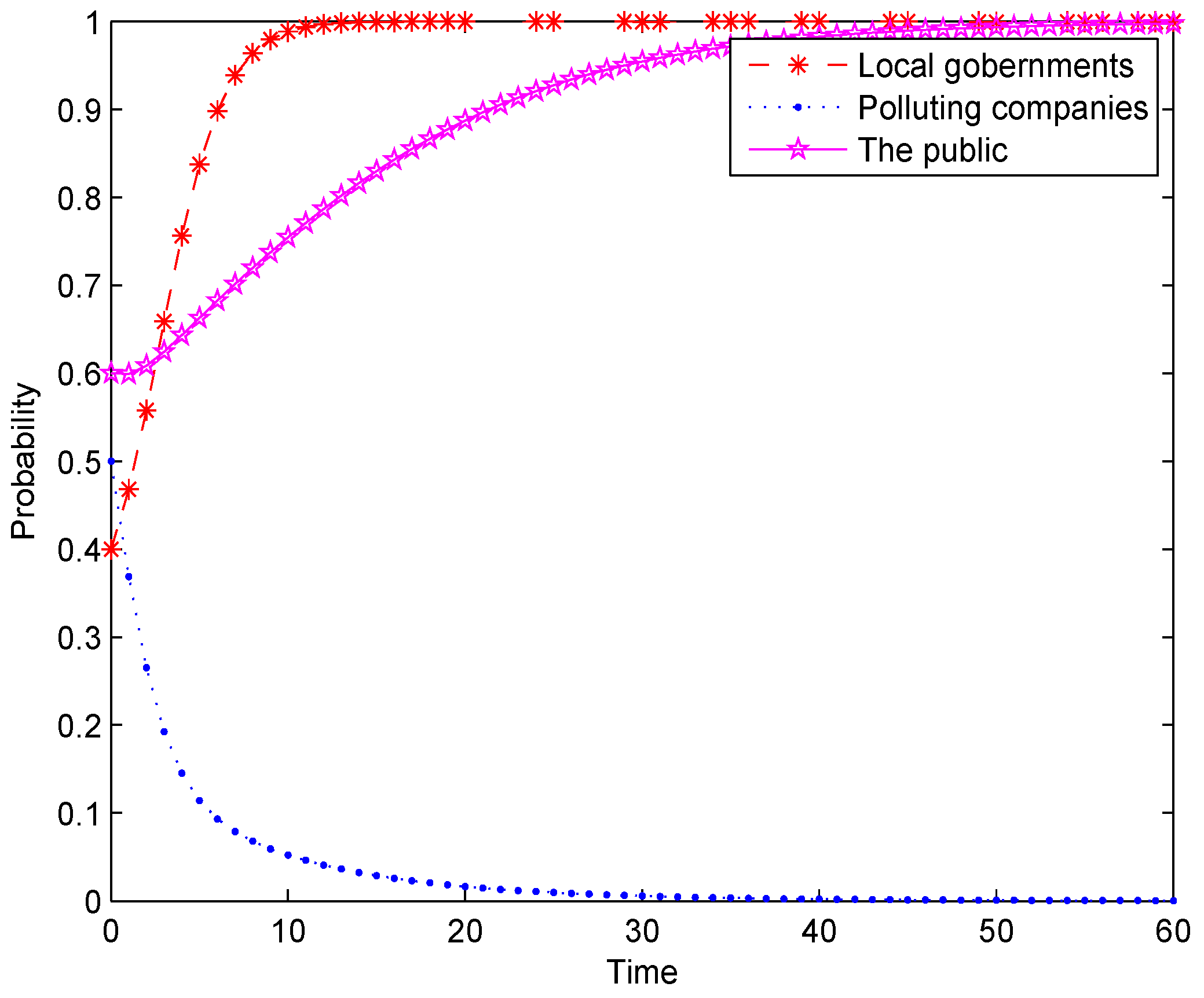
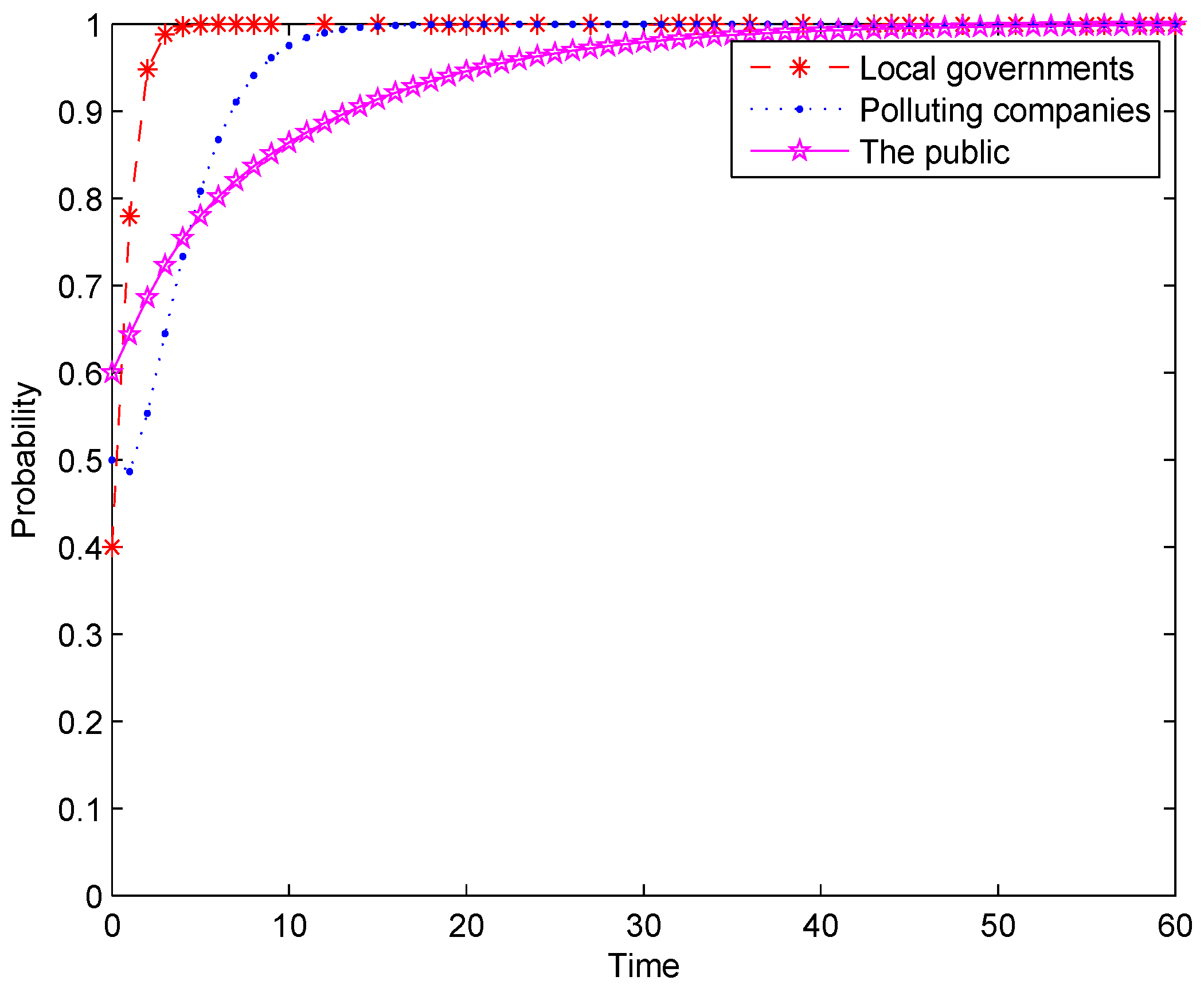
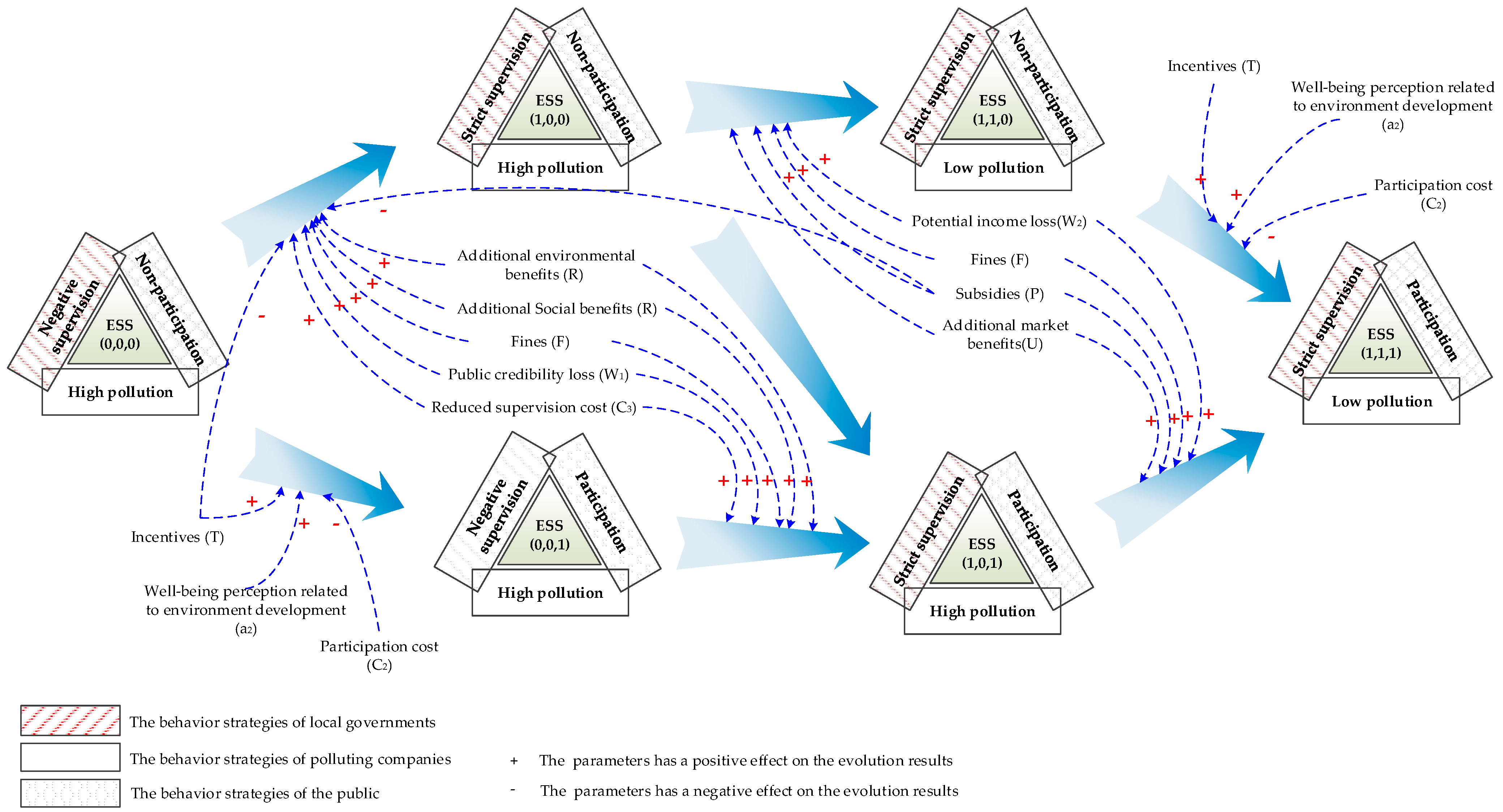
| Parties | Parameters | Descriptions |
|---|---|---|
| Local governments | E0 | Basic economic benefits |
| R | Additional environmental benefits due to positive supervision | |
| S | Additional social benefits due to positive supervision | |
| E | Additional economic benefits due to negative supervision | |
| C0 | Supervision costs of local governments | |
| C3 | Reduced supervision costs due to the public participation | |
| W1 | Public credibility losses due to negative supervision | |
| Polluting companies | U | Additional market benefits for low pollution |
| C1 | Compliance costs for low pollution | |
| F | Fines imposed by local governments for high pollution | |
| P | Subsidizes for low pollution from local governments | |
| W2 | Potential income losses due to public participation e.g., reputation & sales | |
| The public | C2 | Participation costs |
| T | Incentive for the public participation | |
| a1 | Well-being perception related to economic development | |
| a2 | Well-being perception related to environment development |
| Options | Strategies Combination | Local Governments | Polluting Companies | The Public |
|---|---|---|---|---|
| I | (x, y, z) | R + S − C0 + C3 − T − P | U − C1 + P | a1E0 − C2 + T |
| II | (x, y, 1 − z) | R + S − C0 − P | −C1 + P | a1E0 |
| III | (x, 1 − y, z) | R + S − C0 + C3 + F − T | −W2 − F | a1E0 − C2 + T |
| IV | (x, 1 − y, 1 − z) | R + S − C0 + F | −F | a1E0 − a2E0 |
| V | (1 − x, y, z) | E − W1 | U − C1 | a1(E0 + E) − C2 |
| VI | (1 − x, y, 1 − z) | E − W1 | −C1 | a1(E0 + E) |
| VII | (1 − x, 1 − y, z) | E − W1 | −W2 | a1(E0 + E) − C2 |
| VIII | (1 − x, 1 − y, 1 − z) | E − W1 | 0 | a1(E0 + E) − a2(E0 + E) |
| Parameter Change | Phase Diagram Volume Change | Change Direction of Evolution Results |
|---|---|---|
| R increase | K11 enlarge | x→1 |
| S increase | K11 enlarge | x→1 |
| W1 increase | K11 enlarge | x→1 |
| C3 increase | K11 enlarge | x→1 |
| P increase | K12 enlarge, K21 enlarge | x→0, y→1 |
| F increase | K11 enlarge, K21 enlarge | x→1, y→1 |
| U increase | K21 enlarge | y→1 |
| W2 increase | K21 enlarge | y→1 |
| a2 increase | K32 enlarge | z→1 |
| C2 increase | K32 enlarge | z→1 |
| E0 increase | K32 enlarge | z→1 |
| T increase | K12 enlarge, K32 enlarge | x→0, z→1 |
| Equilibrium Strategy | Evolutionary Stability Conditions | Stability |
|---|---|---|
| (1, 1, 1) | R + S − C0 − E + W1 − P + C3 – T > 0; −C1 + U + F + W2 + P > 0; C2 – T < 0 | ESS |
| (1, 1, 0) | R + S − C0 − E + W1 – P > 0; −C1 + F + P > 0; −C2 + T < 0 | ESS |
| (1, 0, 1) | R + S − C0 − E + W1 + F + C3 − T > 0; −C1 + U + W2 + F + P < 0; −C2 + a2E0 + T > 0 | ESS |
| (1, 0, 0) | R + S + W1 − C0 − E + F > 0; −C1 + F + P < 0; −C2 + a2E0 + T < 0 | ESS |
| (0, 1, 1) | R + S + W1 − C0 − E−P + C3 – T < 0; −C1 + U + W2 > 0; C2 < 0 | Unstable |
| (0, 0, 1) | R + S + W1 − E + F + C3 – T < 0; −C1 + U + W2 < 0; −C2 + a2E0 + a2E > 0 | ESS |
| (0, 1, 0) | R + S + W1 − C0 – E – P < 0; C1 < 0; −C2 < 0 | Unstable |
| (0, 0, 0) | R + S + W1 − C0 − E + F < 0; −C1 < 0; −C2 + a2E0 + a2E < 0 | ESS |
Disclaimer/Publisher’s Note: The statements, opinions and data contained in all publications are solely those of the individual author(s) and contributor(s) and not of MDPI and/or the editor(s). MDPI and/or the editor(s) disclaim responsibility for any injury to people or property resulting from any ideas, methods, instructions or products referred to in the content. |
© 2024 by the authors. Licensee MDPI, Basel, Switzerland. This article is an open access article distributed under the terms and conditions of the Creative Commons Attribution (CC BY) license (https://creativecommons.org/licenses/by/4.0/).
Share and Cite
Ding, Q.; Zhang, L.; Huang, S. Research on Environmental Pollution Control Based on Tripartite Evolutionary Game in China’s New-Type Urbanization. Sustainability 2024, 16, 6363. https://doi.org/10.3390/su16156363
Ding Q, Zhang L, Huang S. Research on Environmental Pollution Control Based on Tripartite Evolutionary Game in China’s New-Type Urbanization. Sustainability. 2024; 16(15):6363. https://doi.org/10.3390/su16156363
Chicago/Turabian StyleDing, Qianxing, Lianying Zhang, and Shanshan Huang. 2024. "Research on Environmental Pollution Control Based on Tripartite Evolutionary Game in China’s New-Type Urbanization" Sustainability 16, no. 15: 6363. https://doi.org/10.3390/su16156363
APA StyleDing, Q., Zhang, L., & Huang, S. (2024). Research on Environmental Pollution Control Based on Tripartite Evolutionary Game in China’s New-Type Urbanization. Sustainability, 16(15), 6363. https://doi.org/10.3390/su16156363







